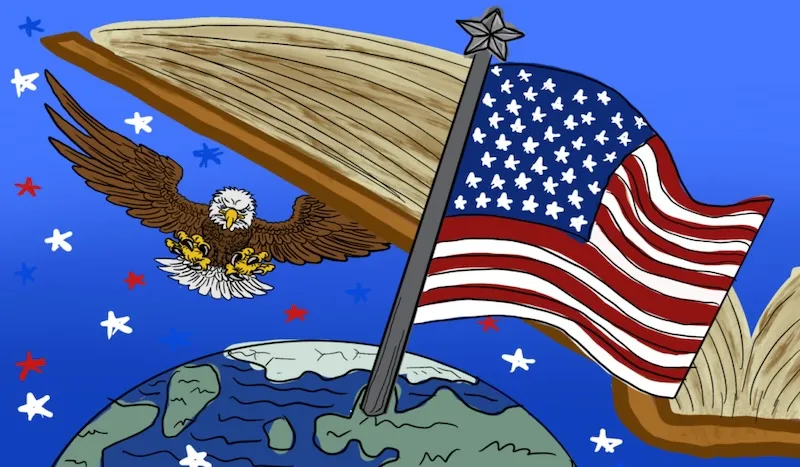
Technologically, the Japanese have nothing to envy the Americans, whether in the electronics sector, artificial intelligence or the automotive industry. Similarly, the time when objects made in China could be considered as junk. Gigantic cities are endowed with the highest technology. In a few years, dozens of villages have been transformed into urban areas. The Chinese are great global suppliers of electronic components. Their wealthy entrepreneurs settled in Africa and project mega-projects in North America, particularly in Quebec. In 2022, the only lithium mine then operational in Canada, located in Manitoba, belonged to the Chinese company Sinomine Resource Group, which sends its production to China…1
The United States has become more speculators than producers. By setting up factories in South-East Asia and China, to save on wages, the US is threatened by this strategy: if local elected officials end the imposed conditions, it is the entire coin chain, designed in various parts, that blocks the final assembly.
As the BRICS countries no longer pay in dollars, Uncle Sam’s grip on international finance is weakening. If African states like Mali and Burkina Faso stop accepting neo-colonialism, at a time when the European Union is submitting to NATO’s belligerentities, the world will fracture more between East and West, North and South, without this being to the benefit of a population that arrogates the name of an entire continent.
The solution: ruining Europe
With its economy based on the relocation of production sites, the end of the dollar hegemony, the rejection of its invasive policy, the only way for the US to regain the power that the Second World War gave it would be to push the European Union into a widespread conflict in Europe.
That would be the surest way to ruin its prosperous nations for years. By making them dependent on the United States, in terms of military equipment and fuel, and then subjecting them to conditions of assistance for reconstruction. Now imagine you’re back in 1947…
The Marshall Plan: a precedent for review
The plan was to help the states of Europe, to restore the infrastructure that was vandalized during World War II. Of the billions granted, in addition to the “gifts”, 15% consisted of loans from US banks, acquired by a government guarantee. Provided that an equivalent sum of equipment, services and products made in the USA2 is imported
Since the American factories had operated at full capacity during the war, with the Marshall Plan, we made sure to maintain the jobs of the citizens, both internally and abroad.
Loans were controlled by the World Bank and the IMF. As the United States proved to have the sole membership in veto power of these institutions, the signatory countries had to abide by their terms: the loans would be provided in dollars and repayable in gold or its equivalent in dollars and not in local currency (the price of gold worth 34 dollars per ounce). The US thus avoided the risk of devaluation of the national currency of borrowers.3
The plan also included a “cultural” section. Since Hollywood productions were not as popular in Europe as in America, especially in France, quotas limiting the distribution of films were disputed. Fi on the protection of national achievements The signatories pledged to screen a minimum of 30% of films produced in Hollywood.4
An alternative to reconsider
The socialists who opposed the Marshall Plan, as well as the Soviets at the time, proposed a means that should be taken into account by many countries: by nationalizing the possessions of wealthy Europeans, one could have obtained the basis for the handover of the economy. In the United States, the opponents suggested forcing large German companies to contribute to the restoration of Europe, since they had caused some destruction, while being enriched by the sale of military supplies.
This idea of nationalizing foreign firms should be adopted by all indebted countries with the World Bank and IMF. The payment of interest often exceeds the amount lent, in addition to forcing nations to privatise their businesses and reduce public services. And no compensation should be offered to them, as their profits have outperformed investments, partly made by governments, with public funds. Moreover, when they stop working, affected locations are rarely cleaned up, despite the country’s environmental laws. Many countries no longer own their water, their best agricultural land, mineral wealth, all exploited by supranational monopolies.
A war with Russia – Europe’s suicide
The United States had not agreed to deploy pointedients towards them from Cuba. Russia does not have to tolerate the US installing military bases on its border with Ukraine. A neutral area is what the Russian government has been asking for, since the beginning of the conflict with its Ukrainian neighbour.
If European leaders do not understand this and are reckless enough to declare a war against Russia, the whole of Europe will suffer, the benefits of the US. Already, many countries have handed over compulsory military service and conscription. In some areas, even women will be forced to do so. This is an egalitarian status that will not please all feminists…
As in the previous two World Wars, the territory of the United States might not be affected. And after doing everything possible to undermine the Minsk I and II Peace Accords, a generalized war in Europe would subject its nations to a Marshall neo-plane. Think about it, when the mainstream media repeats, like automatons, that it is the Russians who want war.
